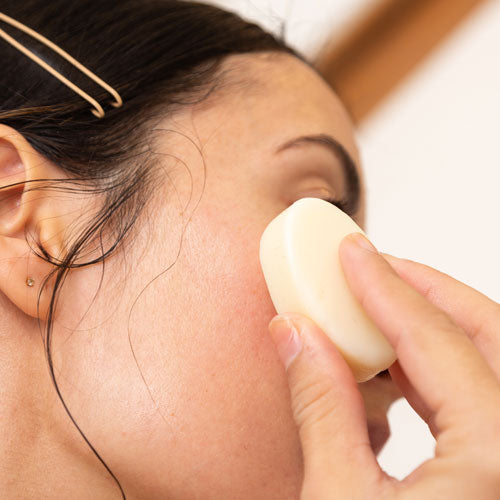As formulators of skincare and beauty, one of our most frequently asked questions is “are your products non-comedogenic?” Before we dive into answering this question – and it’s a good one – let’s go back to basics and cover what this actually means.
The term “comedogenic” is derived from the word comedones - the general term for plugged follicular orifices or, in non-dermatological jargon, clogged pores. Open comedones are commonly referred to as blackheads – where the exposure to oxygen has caused oxidation of the trapped keratinous content, causing it to darken – and whiteheads are closed comedones, where sebum and bacteria are trapped beneath a layer of skin.

Comedogenicity is acknowledged in the skincare industry as a measure of how likely an ingredient or product is to clog pores. Substances that are comedogenic are said to block pores and cause congestion and breakouts, whilst non-comedogenic ones are less likely to.
In the skincare world, products that are identified as being non-comedogenic are hence seen as far more desirable, as they theoretically help the user avoid the associated effects of clogged pores such as acne. We’re trained into seeking out non-comedogenic products, and conditioned into thinking that certain ingredients are comedogenic, and others aren’t, so we know what to avoid. But is this true? Should we be avoiding anything that’s not clearly marked as non-comedogenic?
In short – no.
For starters, comedogenicity is not closely regulated, and there is no scientific measure or metric unit that measures how comedogenic a substance might or might not be. There is presently no standard for what comedogenicity actually means - even the FDA (Food and Drug Administration) in the USA does not have a definition for the term “non-comedogenic”.

The comedogenicity scale rates ingredients from 0 (non-comedogenic) to 5 (very comedogenic). Most of these ratings have been derived from animal testing (disappointingly), where ingredients are smeared on the inside of a rabbit’s ear. Rabbits are used as their skin is more sensitive than ours, and hence reacts quicker. Because we’re not rabbits, this test really doesn’t stack up in the real world – as numerous studies have subsequently proven. The tests that have been done on humans had very small sample sizes and were tested on the skin of people’s backs and legs, not their faces. Again, this is not an accurate representation of how the ingredient would work in the real world.
Concentration is another factor. Something that is deemed very comedogenic at 100% concentration typically becomes much less so at 50% concentration. So, in formulations, the comedogenicity scale becomes even more useless. As an example, smearing a thick layer of 100% coconut oil on your face may cause you to break out, but 10% in your moisturizer would have little to no impact.
It’s also worth noting that oftentimes, products are more than just a sum of their parts. Just because a product may contain an ingredient that is known to be comedogenic, does not mean that the product itself is likely to be – especially in the case of rinse-off products such as shampoos and cleansers. Cleansing products contain surfactants – surface acting agents – which are emulsifying substances which bind oil and water together. Even if a cleanser contains a comedogenic ingredient, the surfactants will bind to this oil as well as the oils on the skin, washing them away.
Long story short: comedogenicity is a catch-all phrase, as different oils have different effects on different individuals and there is no real, scientific 'comedogenic' scale. Some individuals may find that cocoa butter or olive oil cause congestion, for example, but others are able to use them with no adverse effects. This is largely dependent on individual sensitivities and skin types.

Our advice? If you have concerns over a product potentially causing congestion or clogged pores, try a sample wherever possible, and use the product as directed. If you are changing multiple products in your skincare routine, try only changing one product at a time. This makes it easier to determine whether the product is agreeing with your skin and helping improve its condition, or not. This is good practice for any new product, particularly if you have sensitive skin.
Scouring the reviews section is also super helpful, as feedback from others who have tried and tested the products always provides good insight as everyone has such different skin types and sensitivities.
Still unsure? No worries! Drop us a line at hello@ethique.com to chat to our wonderful Miracle Workers and Product Team. We also have a product guarantee to ensure you find a product which works for you.
References:
https://labmuffin.com/fact-check-how-to-use-comedogenicity-ratings/
https://www.beautifulwithbrains.com/things-need-know-comedogenicity-ratings/
https://zarzoubeauty.com/blog/why-comedogenic-rating-cant-be-a-good-guideline/
WE Morris and SC Kwan, Use of the rabbit ear model in evaluating the comedogenic potential of cosmetic ingredients, J Soc Cosmet Chem 1983, 34, 215-225.
ZD Draelos and JC DiNardo, A re-evaluation of the comedogenicity concept, J Am Acad Dermatol 2006, 54, 507-512.
JE Fulton, Comedogenicity and irritancy of commonly used ingredients in skin care products, J Soc Cosmet Chem 1989, 40, 321-333.

 Impact
Impact Blog
Blog Store Locator
Store Locator


